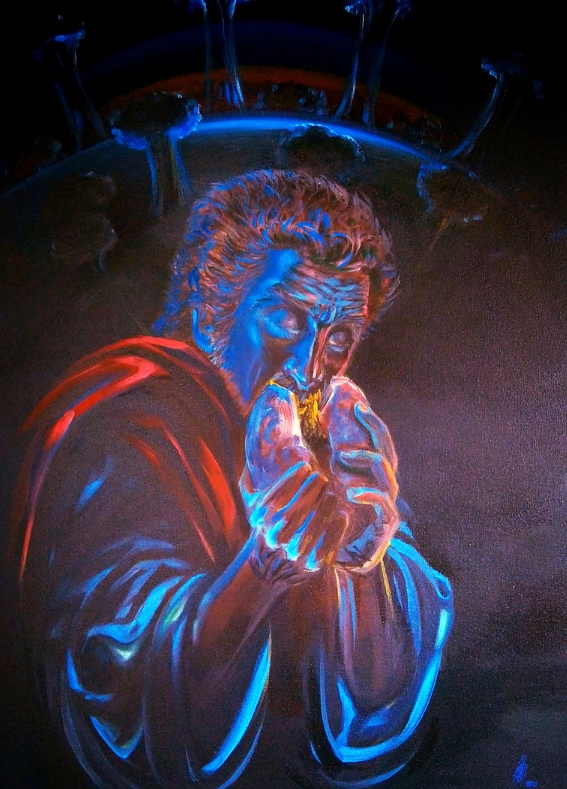You are intruding upon a private feast,
but in his olfactory trance, he is
impervious to your presence.
Bathed in blue light, Joyson's work
distantly echoes a Picassian Blue Period
painting, but the contrasts are rife and
intriguing. The present subject is hale unlike
his bread-eating counterparts in The Ascetic
(1903) and The Blind Man's Meal (1903) whose
lopsided and hollow countenances evidence
their poverty. The muted blues in Picasso's
paintings speak to the grim melancholy of
his subjects' lives whereas the electric blue
in Joyson's work gives the impression of
security and comfort. It is offset, however, by
the electric red that counters its tranquility,
hinting at a burning unease.
The serene eyes and the furrowed
forehead, like the blue and the red tell
different stories. Joyson wrote that he was
affected by "the comfortable security [of]
home" and the fates of migrant workers who
are "wading across an ocean of uncertainty".
He projected his helplessness and guilt
onto his subject whose heavy robes weigh
him down. His crouching posture and his
closed eyes represent an escape from and,
simultaneously, the inescapability of reality.
Compare this with the elderly man in Eric
Enstrom's Grace (1918). He, too, is bent over
his meal, but more in gratitude than in
distress. Similarly, Corbert Gauthier's Christ
in Bread of Life shows a calm disposition as he
consecrates bread.
Unlike his aforementioned Picassian
counterparts, who clutch a meager heel of
bread, our man is on the verge of devouring
an entire loaf. The prominent gold highlights
on his beard and lips draw our attention
not merely to his hunger but also to the fact
that food is a luxury. He almost seems like
someone furtively opening a satchel of gold.
The title of the painting merits a
discussion of its own. Literally, it delivers, but
its significance doesn't end there.
It prompts
an unavoidable reminiscence of the biblical
course of breaking bread. From the Feeding of
the Five Thousand to the Last Supper all the
way to the Acts of the Apostles, the breaking
of bread was a communal and not a solitary
affair. The darkness effectively heightens the
subject's loneliness by obscuring the details of
his surroundings.

When contextualized against the (literal)
background, everything falls into place. It
is painted quite deceptively. At first glance
it might come across as a surreal, desolate
landscape, but it is actually a hemispheric
rendition of the coronavirus with a malicious
glint. The artist shows that the threat of the
pandemic looms large and that the thought of
it intrudes upon every waking moment.∎
Title Break the Bread
Artist Joseph Joyson OFM Cap
Medium Acrylic on stretched canvas
Dimension 124x92 cm
Date May 2020